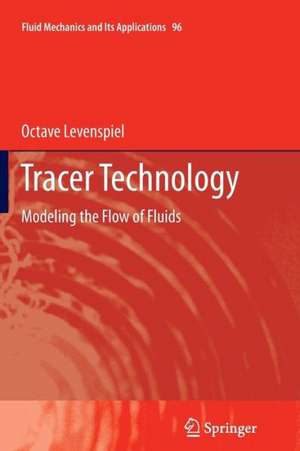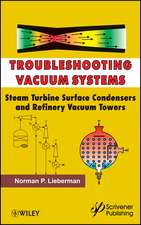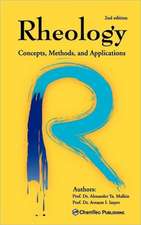Tracer Technology: Modeling the Flow of Fluids: Fluid Mechanics and Its Applications, cartea 96
Autor Octave Levenspielen Limba Engleză Paperback – 25 ian 2014
Tracer Technology, written by Octave Levenspiel, shows how we use tracers to follow the flow of fluids and then we develop a variety of models to represent these flows. This activity is called tracer technology.
| Toate formatele și edițiile | Preț | Express |
|---|---|---|
| Paperback (1) | 549.02 lei 38-44 zile | |
| Springer – 25 ian 2014 | 549.02 lei 38-44 zile | |
| Hardback (1) | 638.43 lei 6-8 săpt. | |
| Springer – 17 noi 2011 | 638.43 lei 6-8 săpt. |
Din seria Fluid Mechanics and Its Applications
- 17%
 Preț: 462.81 lei
Preț: 462.81 lei - 23%
 Preț: 692.07 lei
Preț: 692.07 lei - 18%
 Preț: 1014.58 lei
Preț: 1014.58 lei - 17%
 Preț: 524.77 lei
Preț: 524.77 lei - 15%
 Preț: 646.30 lei
Preț: 646.30 lei - 18%
 Preț: 789.65 lei
Preț: 789.65 lei - 18%
 Preț: 780.82 lei
Preț: 780.82 lei - 20%
 Preț: 630.18 lei
Preț: 630.18 lei - 20%
 Preț: 696.89 lei
Preț: 696.89 lei - 18%
 Preț: 897.65 lei
Preț: 897.65 lei - 18%
 Preț: 1577.13 lei
Preț: 1577.13 lei - 15%
 Preț: 539.41 lei
Preț: 539.41 lei - 18%
 Preț: 1112.30 lei
Preț: 1112.30 lei - 18%
 Preț: 1116.89 lei
Preț: 1116.89 lei - 24%
 Preț: 1069.07 lei
Preț: 1069.07 lei -
 Preț: 443.31 lei
Preț: 443.31 lei - 15%
 Preț: 583.93 lei
Preț: 583.93 lei - 24%
 Preț: 1068.78 lei
Preț: 1068.78 lei - 24%
 Preț: 961.15 lei
Preț: 961.15 lei - 18%
 Preț: 835.15 lei
Preț: 835.15 lei - 18%
 Preț: 960.61 lei
Preț: 960.61 lei - 18%
 Preț: 949.55 lei
Preț: 949.55 lei - 18%
 Preț: 957.76 lei
Preț: 957.76 lei - 15%
 Preț: 590.27 lei
Preț: 590.27 lei - 15%
 Preț: 651.19 lei
Preț: 651.19 lei - 15%
 Preț: 646.62 lei
Preț: 646.62 lei - 15%
 Preț: 655.78 lei
Preț: 655.78 lei - 18%
 Preț: 1660.65 lei
Preț: 1660.65 lei - 18%
 Preț: 1087.54 lei
Preț: 1087.54 lei - 15%
 Preț: 644.30 lei
Preț: 644.30 lei - 24%
 Preț: 786.44 lei
Preț: 786.44 lei - 18%
 Preț: 1582.35 lei
Preț: 1582.35 lei - 18%
 Preț: 958.07 lei
Preț: 958.07 lei
Preț: 549.02 lei
Preț vechi: 686.28 lei
-20% Nou
Puncte Express: 824
Preț estimativ în valută:
105.07€ • 114.09$ • 88.26£
105.07€ • 114.09$ • 88.26£
Carte tipărită la comandă
Livrare economică 18-24 aprilie
Preluare comenzi: 021 569.72.76
Specificații
ISBN-13: 9781489992116
ISBN-10: 1489992111
Pagini: 160
Ilustrații: XII, 148 p.
Dimensiuni: 155 x 235 x 8 mm
Greutate: 0.23 kg
Ediția:2012
Editura: Springer
Colecția Springer
Seria Fluid Mechanics and Its Applications
Locul publicării:New York, NY, United States
ISBN-10: 1489992111
Pagini: 160
Ilustrații: XII, 148 p.
Dimensiuni: 155 x 235 x 8 mm
Greutate: 0.23 kg
Ediția:2012
Editura: Springer
Colecția Springer
Seria Fluid Mechanics and Its Applications
Locul publicării:New York, NY, United States
Public țintă
ResearchCuprins
The Tracer Method.- The Mean and Variance of a Tracer Curve.- The E and the F Curves.- Two Ideal Flow Models - Plug Flow and Mixed Flow.- Compartment Models.- The Dispersion Model.- Intermixing Between Flowing Fluids.- The Tanks-in-Series Model.- Convection Model for Laminar Flow in Pipes.- Batch Systems.- The Stirred Tank - Mixing Time and Power Requirement.- Meandering Flow and Lateral Dispersion.
Textul de pe ultima copertă
A vessel’s behavior as a heat exchanger, absorber, reactor, or other process unit is dependent upon how fluid flows through the vessel. In early engineering, the designer would assume either plug flow or mixed flow of the fluid through the vessel. However, these assumptions were oftentimes inaccurate, sometimes being off by a volume factor of 100 or more. The result of this unreliable figure produced ineffective products in multiple reaction systems.
Written by a pioneering researcher in the field of chemical engineering, the tracer method was introduced to provide more accurate flow data. First, the tracer method measured the actual flow of fluid through a vessel. Second, it developed a suitable model to represent the flow in question. Such models are used to follow the flow of fluid in chemical reactors and other process units, like in rivers and streams, or solid and porous structures. In medicine, the tracer method is used to study the flow of chemicals—harmful and harmless—in the bloodstreams of humans and animals.
Tracer Technology – Modeling the Flow of Fluids discusses how tracers are used to follow the flow of fluids, and how a variety of models are developed to represent these flows.
Octave Levenspiel is Professor Emeritus of Chemical Engineering at Oregon State University. His primary interest is chemical reaction engineering, focusing largely on applying chemical reaction kinetics and physics to the design of chemical reactors. His work has been recognized with awards that include the R.H. Wilhelm award (AIChE), the W.K. Lewis award (AIChE), and the P.V. Danckwerts award (IChemE). His previous books, including Chemical Reaction Engineering, The Chemical Reactor Omnibook, and Engineering Flow and Heat Exchange, are widely used in industry and teaching, and have been translated into 12 foreign languages.
Written by a pioneering researcher in the field of chemical engineering, the tracer method was introduced to provide more accurate flow data. First, the tracer method measured the actual flow of fluid through a vessel. Second, it developed a suitable model to represent the flow in question. Such models are used to follow the flow of fluid in chemical reactors and other process units, like in rivers and streams, or solid and porous structures. In medicine, the tracer method is used to study the flow of chemicals—harmful and harmless—in the bloodstreams of humans and animals.
Tracer Technology – Modeling the Flow of Fluids discusses how tracers are used to follow the flow of fluids, and how a variety of models are developed to represent these flows.
Octave Levenspiel is Professor Emeritus of Chemical Engineering at Oregon State University. His primary interest is chemical reaction engineering, focusing largely on applying chemical reaction kinetics and physics to the design of chemical reactors. His work has been recognized with awards that include the R.H. Wilhelm award (AIChE), the W.K. Lewis award (AIChE), and the P.V. Danckwerts award (IChemE). His previous books, including Chemical Reaction Engineering, The Chemical Reactor Omnibook, and Engineering Flow and Heat Exchange, are widely used in industry and teaching, and have been translated into 12 foreign languages.
Caracteristici
Shows how to use tracers to follow the flow of fluids and develops a variety of models to represent these flows Provides examples and problems to enhance understanding of concepts Written by a pioneering researcher in the field of chemical engineering Includes supplementary material: sn.pub/extras










